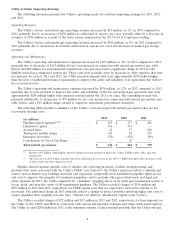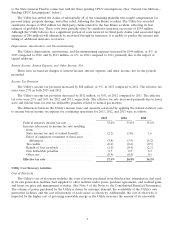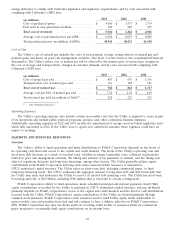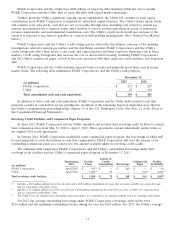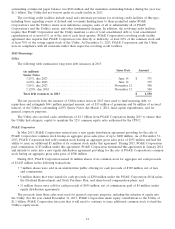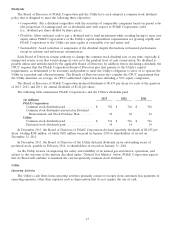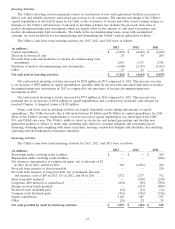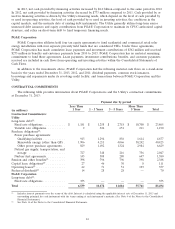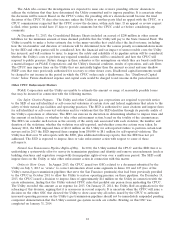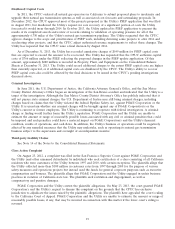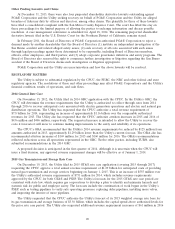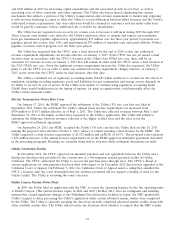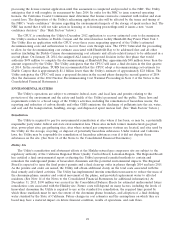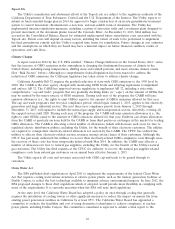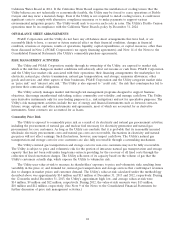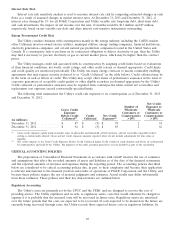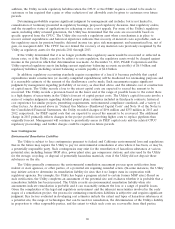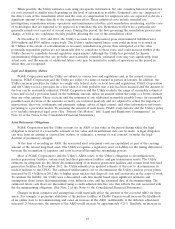PG&E 2013 Annual Report Download - page 24
Download and view the complete annual report
Please find page 24 of the 2013 PG&E annual report below. You can navigate through the pages in the report by either clicking on the pages listed below, or by using the keyword search tool below to find specific information within the annual report.The ALJs who oversee the investigations are expected to issue one or more presiding officers’ decisions to
address the violations that they have determined the Utility committed and to impose penalties. It is uncertain when
the decisions will be issued. Based on the CPUC’s rules, the presiding officer’s decisions would become the final
decisions of the CPUC 30 days after issuance unless the Utility or another party filed an appeal with the CPUC, or a
CPUC commissioner requested that the CPUC review the decision, within such time. If an appeal or review request
is filed, other parties would have 15 days to provide comments but the CPUC could act before considering any
comments.
At December 31, 2013, the Consolidated Balance Sheets included an accrual of $200 million in other current
liabilities for the minimum amount of fines deemed probable that the Utility will pay to the State General Fund. The
Utility is unable to make a better estimate due to the many variables that could affect the final outcome, including
how the total number and duration of violations will be determined; how the various penalty recommendations made
by the SED and other parties will be considered; how the financial and tax impact of unrecoverable costs the Utility
has incurred, and will continue to incur, to improve the safety and reliability of its pipeline system will be considered;
whether the Utility’s costs to perform any required remedial actions will be considered; and how the CPUC will
respond to public pressure. Future changes in these estimates or the assumptions on which they are based could have
a material impact on PG&E Corporation’s and the Utility’s financial condition, results of operations, and cash flows.
The CPUC may impose fines on the Utility that are materially higher than the amount accrued and may disallow
PSEP costs that were previously authorized for recovery or other future costs. Disallowed capital investments would
be charged to net income in the period in which the CPUC orders such a disallowance. See ‘‘Disallowed Capital
Costs’’ below. Future disallowed expense and capital costs would be charged to net income in the period incurred.
Other CPUC Enforcement Matters
PG&E Corporation and the Utility are unable to estimate the amount or range of reasonably possible losses
that may be incurred in connection with the following matters.
Gas Safety Citation Program. The Utility and other California gas corporations are required to provide notice
to the SED of any self-identified or self-corrected violations of certain state and federal regulations that relate to the
safety of their natural gas facilities and operating practices. The SED is authorized to issue citations and impose fines
for self-identified or self-corrected violations and for violations that the SED identifies through its periodic audits of
the Utility’s operations or otherwise. The SED can exercise its discretion in determining whether to impose fines and
the amount of such fines, or whether to take other enforcement action, based on the totality of the circumstances.
The SED can consider such factors as the severity of the safety risk associated with each violation; the number and
duration of the violations; whether the violation was self-reported, and whether corrective actions were taken. In
January 2012, the SED imposed fines of $16.8 million on the Utility for self-reported failure to perform certain leak
surveys and in 2013 the SED imposed fines ranging from $50,000 to $8.1 million for self-reported violations. The
Utility has filed over 50 self-reports with the SED, plus additional follow-up reports, that the SED has not yet
addressed. The SED is expected to impose fines or take enforcement action with respect to some of these
self-reports.
Natural Gas Transmission Pipeline Rights-of-Way. In 2012, the Utility notified the CPUC and the SED that it is
undertaking a system-wide effort to survey its transmission pipelines and identify and remove encroachments (such as
building structures and vegetation overgrowth) from pipeline rights-of-way over a multi-year period. The SED could
impose fines on the Utility or take other enforcement action in connection with this matter.
Orders to Show Cause. In August 2013, the CPUC issued two OSCs related to a document submitted by the
Utility on July 3, 2013 as ‘‘errata’’ to correct information about some segments in Lines 101 and 147 (two of the
Utility’s natural gas transmission pipelines that serve the San Francisco peninsula) that had been previously provided
to the CPUC in October 2011 to allow the Utility to restore operating pressure on these pipelines. On December 19,
2013, the CPUC issued a decision to impose fines of approximately $14 million on the Utility in connection with the
errata submission, finding that the Utility violated CPUC rules that prohibit any person from misleading the CPUC.
The Utility recorded this amount as an expense for 2013. On January 23, 2014, the Utility filed an application for the
rehearing of this decision, arguing that it is erroneous in several respects. It is uncertain when the CPUC will issue a
decision on the other OSC that directed the Utility to show cause why all orders issued by the CPUC to authorize
increased operating pressure on the Utility’s gas transmission pipelines should not be immediately suspended pending
competent demonstration that the Utility’s natural gas system records are reliable. Briefing on this OSC was
completed on January 31, 2014.
18


